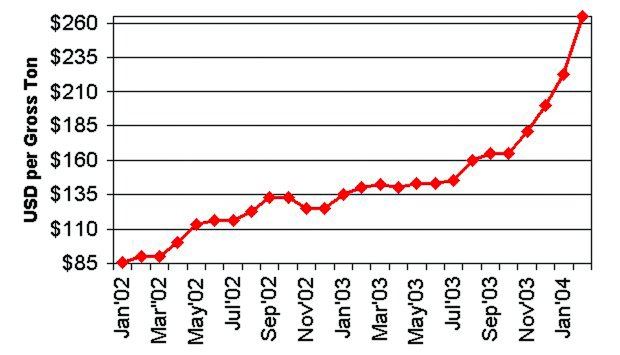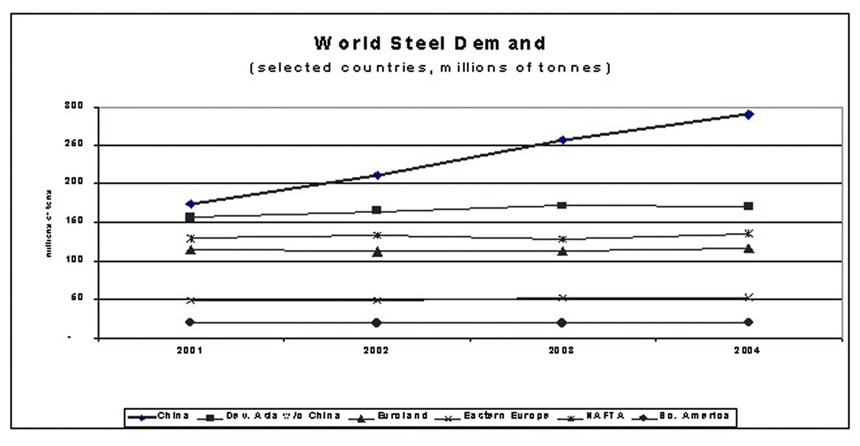| U.S. and global steel prices have soared in the past months, far beyond levels that anyone inside or outside of the steel industry forecasted last November and December. The purpose of this article is to explain the primary causes of the sudden increase in prices and to provide some insight into the future direction of prices based on an understanding of long-term factors. Hopefully, this information will be helpful to those moldmakers with regard to planning for the short and long term.
Cause #1: Chinese Consumption
It is fairly well known that the primary cause of the increase in global prices has been a rapid increase in steel consumption in China. Figure 1 demonstrates how dramatic this increase is, showing world steel demand over the past few years. The basic message of this graph is that nearly all of the world's increase in consumption has occurred in China; for the rest of the world, steel consumption has been flat. This graph could be taken back even farther and still have the same picture. Since 1997, China has increased consumption from about 100 million tons to around 260 million tons in 2003. This is nearly double the U.S. consumption based on the 2003 figures. It is too early to know for sure how 2004 will finish, but most analysts estimate that China's total consumption will be at least in the area of about 290 million tons. At the same time China's steel making capacity has also increased, but not as fast as the increase in consumption. Figure 2 shows China's steel making capacity compared to its consumption.
Cause #2: Raw Material Shortages
Scrap
Scrap is being consumed at a rate that is faster than it is being created. Newly developing countries do not have old scrap. Scrap is generated from the abandonment of used steel articles. Most countries in the world simply do not consume enough steel objects to generate significant quantities of scrap. The result of this shortage in scrap has been an unprecedented run-up in scrap prices. Scrap prices have always been volatile, but the variation has been around a much lower price trend. Figure 3 shows the rapid run-up in scrap in just a few months; scrap prices increased at a great speed. The imbalance between production from the basic oxygen furnace and electric furnace production is going to continue to put pressure on the scrap supply. This is going to keep scrap prices higher than historic trend levels for the next several years. Again, since scrap is 100 percent of their supply, mini mill steel makers have no choice but to pass the increased costs on to their customers.
Iron Ore
Beyond scrap there are also shortages of iron ore. Over the past 20 years there has been very little investment in iron ore mines. Only in South America and China has any significant investment taken place. The cause of this dis-investment in iron ore was the belief that the electric furnace was the production method of choice since it had an apparent cost advantage over the integrated steel making blast furnace approach. This was supported by the misguided belief that there would be an endless supply of cheap scrap in the world. In fact there is not. Now that the demand for steel has increased due to China, the shortage of iron ore capacity is starting to become apparent.
Coke
Probably more critical at this stage than scrap or iron ore is the global supply of coke. Coke is made from coal by furnaces that bake off impurities, such as sulfur and ash, and bring out the pure carbon in the coal. In the developed world, environmental regulation has forced most old furnaces to shut down. Very few new furnaces have been built in recent years. Consequently, there is a shortage of coke in the U.S. and the world. In the U.S. only the Steel Corporation is self-sufficient in coke. All other domestic steel companies must buy coke on the open market. Much of it, in the past, has come from China. China is now restricting the export of coke to save for its own internal uses. Figure 4 shows the increase in coke prices. Once again, note the speed at which prices increased.
Cause and Effect
| Structural Change |
| The questions most people are contemplating are: to what extent will steel prices retreat in future months, and will they stay low? Veterans in the steel industry and steel users have seen steel prices spike many times in the past, only to quickly retreat, many times to new all time lows. Are we likely to see a return to this type of pattern any time soon or have we seen a true structural change in the global steel industry, one that will alter the familiar pattern of pricing? We have experienced a structural change in the steel industry and that this will change pricing patterns for at least the next several years.
The seeds of the structural change were sown more than 20 years ago. Since the early 1980s, profitability in the global steel industry has been well below its cost of capital. When an industry does not earn it's cost of capital it does not re-invest in infrastructure. As a result, throughout the last 20 years there has been little investment in infrastructure. Investment has been mostly in finishing mills and electric furnaces. As you will see this investment has actually exacerbated the problem.
The wave of steel making capacity built in the 70s and 80s by emerging economies, coupled with the capacity released from the dissolution of the USSR in the late 80s, led to a large amount of excess capacity in the global steel market. As recently as last summer, conventional wisdom put global steel supply at about one billion tons and global steel demand around 850 million tons. Since that time this overhang in supply has melted away due to the increase in demand from China and the rest of the world ending its cyclical economic downturn. As China's steel consumption has been growing, it has not only filled up the world's excess capacity, but it has also put pressure on the global supply of raw materials for steel making.
|
The final result of all these shortages is twofold (see Structural Change sidebar). First, costs for steel making have gone up. Since these costs have gone up across all companies all companies have sought to recoup the extra costs. Of course, costs do not set the price of a product; the market sets the price.
The other impact from these shortages is supply and demand. The global steel market has shifted in favor of the supplier. However, the shortages of scrap, iron ore and coke have had the effect of taking capacity out of the market. Most steel companies are not capable of running at full capacity. They are losing production turns due to shortages.
Cause #3: Shipping
The final shortage item is shipping. Other industries also are experiencing a problem with shipping capacity. One of the reasons international trade grew so much over the past decade is that shipping costs went down. However, trade has grown so much that there is now a shortage of shipping. The higher cost of shipping is keeping some steel from being exported to the U.S. and is hampering the movement of raw materials around the globe. This shortage in shipping is not going to correct itself anytime soon. The top priority for shipyards is to build tankers, especially with the demand for double hull tankers increasing. Next in priority is to build cargo ships and last is to build bulk carriers. Steel and raw materials ship in bulk carriers. It is expected that it will take years to build enough bulk carriers to relieve the shortage.
Cause #4: Global Pressure
Our discussion of shortages has been to highlight the fact that the increase in steel demand in China has put pressure on the global infrastructure for steel. This infrastructure includes more than just steel making capacity and rolling mill capacity. It is much deeper. Until demand increased it was hardly even noticed that these fault lines existed. It will take a long time for this infrastructure capacity to be increased. We do not believe it can be improved in less than a three- to five-year period. It appears that the current infrastructure cannot support global consumption near the level of one billion tons even though theoretical capacity says that it can.
It is true that China is planning to increase its own steel making capacity. The Chinese government recently announced that it plans to add 120 million tons of steel making capacity in the next few years. The key point is that even if it adds the capacity it will not solve the problem. There are not enough raw materials to go around; therefore, additional capacity will only add to the problem, not solve it. The Chinese impact on supply and demand is likely to last for several years to come.
Based on the understanding of the world supply and demand situation, it is difficult to see prices retreating a great deal. We will probably see prices level off and plateau soon and they are likely to retreat some time in the second half of this year. However, they are not likely to drop a great deal as they have in the past. A 20 percent drop in prices may be likely, but it is just as likely that prices will rebound shortly thereafter, maybe not to current levels but not very far from them either.
We can conclude this discussion with a few thoughts. If we accept the premise that the market dynamics on a global basis has changed, how does a steel consumer move forward? The best strategy for the future, for steel consumers, is to work to establish a relationship with a steel supplier. A real old- fashioned relationship where companies work together to solve problems and look for ways to work together that are in the best interest of both parties. For the past several years, these kinds of relationships seem to have gone out of style and were replaced by an adversarial system designed to drive down prices to the lowest point possible. This will be unsuccessful in the future and consumers must reconsider their options.
| Moldmaking Challenges |
"Costs have risen for tool steel, but as far as we have seen not to the extent of the cheaper steels which use scrap. In talking to one of our mold base suppliers, he has had problems getting steel and stated that it costs more now for #1 steel than #2. It is a big concern for him and in the long run our business. We are factoring a slightly higher number now for supplies than in the past. Most of this is based upon steel costs. This could present a huge problem in the long run. If we can't get steel, we are gone. It's a bit scary that not only has China had a major impact on what we put out the door it seems now they can affect what comes in our door. Longer term impacts could be devastating. The automotive as well as most other industries in the U.S and other countries could and most likely will be affected. It will be interesting to see how this affects our economy in 10 years. "
-Gene Bruce, Vice President and Co-owner, Summit Molds, Inc. (Post Falls, ID) and MoldMaking Technology EAB member.
"We all keep down costs by checking prices at various vendors and neither us or our outside mold shops use any kind of factor in quoting. Our molds are small high precision molds where steel cost is a very small part of the cost. Large molds would obviously be more affected by rising steel costs. Price and availability have not been a problem so far. In the long run (three to five years) we feel this could become a problem for all of us. One of my outside mold shop owners told me he no longer eats steel that contains flaws. I asked him how often that happens and he told me twice in the last two months."
-Russ Westergaard, Tooling Manager, All West Plastics, Inc. (Antioch, IL) and MoldMaking Technology EAB member.
|
|














.jpg;maxWidth=300;quality=90)
_300x250 4.png;maxWidth=300;quality=90)













